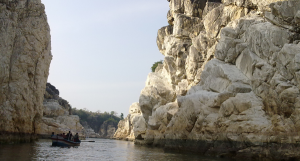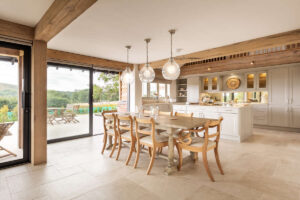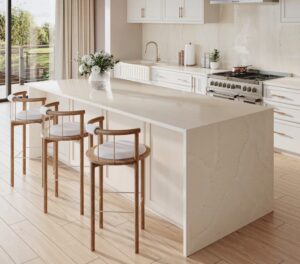How is Marble Formed and Where Does it Come From?
Marble is a beautiful, natural stone that has been used as a dimension stone to make buildings and artworks for thousands of years in some very famous places, for example, you’ll see Marble floors in the Pantheon, Buckingham Palace and the Taj Mahal. The word “marble” derives from the Ancient Greek word “mármaros”, which means “shining stone” or “crystalline rock.” The Greek term itself is believed to have originated from an earlier word, possibly from the Phoenician or Semitic languages, which referred to a similar type of stone. Our experts know how precious Marble is so below we’re looking at how marble is formed and where Marble is found.
How Is Marble Formed?
Marble is a metamorphic rock, which means ‘rock that has changed’. Metamorphic rocks are formed from other materials already existing on the earth’s surface, primarily composed of calcite or dolomite minerals. Calcite is a form of calcium carbonate (CaCO3), and it commonly occurs as crystals within the marble matrix.
During the metamorphic process that forms marble, the original sedimentary rocks, such as limestone or dolomite, undergo intense heat and pressure. These conditions cause the minerals within the rock to recrystallize and rearrange, giving rise to the characteristic interlocking calcite crystals seen in marble.
The size, shape, and arrangement of the crystals can vary when marble forms, depending on factors such as the duration and intensity of the metamorphic process. In some cases, the crystals may be large and easily visible, giving the marble a distinctive crystalline appearance. In other instances, the crystals may be smaller and densely packed, resulting in a smoother texture.
The presence of calcite crystals in marble contributes to its aesthetic appeal and gives it a unique pattern and colouration. The crystals can reflect light, producing a characteristic lustre and enhancing the visual appeal of the stone.
Marble can contain mineral impurities in addition to its primary calcite or dolomite mineral composition. These impurities can introduce various colours and patterns to the marble, resulting in a wide range of aesthetically pleasing variations. Some common mineral impurities found in marble include clay minerals, iron oxides, micas, graphite, pyrite, and quartz.
It’s important to note that the presence and type of mineral impurities in marble can vary depending on the specific geological conditions and location where the marble was formed. As a result, different types of marble can exhibit different impurities, resulting in a wide range of colours, patterns, and characteristics.
Igneous rocks are formed directly from lava or the earth’s molten core. Marble is formed from limestone. In geological terms, Marble is a crystallized form of limestone or dolomite.
Stonecutters use a broader definition – we’ll call the crystallized forms of a few other stones Marble, too, as they have similar veining and take the same high gloss polish in a way other stones don’t. This is because stone cutters have been working with Marble for thousands of years, long before anyone could tell the difference between calcium carbonate and magnesium silicate. They both look beautiful, so what does it matter?
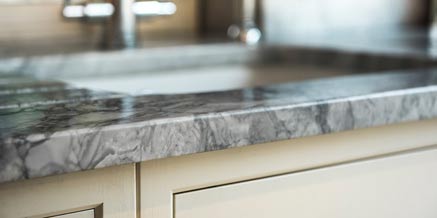
Limestone is usually formed from shells, coral and algae that have collected on the seafloor and being compressed over thousands of years. Sometimes, the shells and bones of creatures that lived long ago survive this process. As a result, you can sometimes still see fossils in your marble floor or tiles.
What is marble made of?
Marble is made of a unique mixture of limestone and various carbonate minerals. The beautiful and unique patterns in natural Marble are a major reason for its value as these patterns are formed by deposits of minerals that existed in the limestone before it was affected by extreme heat being pressurized and heated in the earth’s crust. The minerals react to the pressure differently than the stone did, forming veins and patterns.
How are the colours formed in Marble?
When you think of Marble, you probably picture a milky white colour but this isn’t the only option available! Due to the presence of various minerals and salts, Marble takes on many coloured marble varieties, from pure white to shimmering greens; these different colours are caused by different substances. For example, black veins or grey shading is usually caused by carbon impurities while green is linked to serpentine.
Pure white marble refers to a type of marble that is predominantly white in colour, without significant impurities or veining. It is valued for its clean, elegant appearance and is often associated with luxury and sophistication. It is highly sought after for various architectural and decorative applications, including countertops, flooring, wall cladding, sculptures, and other artistic creations.
One well-known example of pure white marble is Carrara marble, which is quarried in the Carrara region of Italy. Carrara marble is renowned for its bright white colour and fine, uniform grain. It has been used for centuries in famous structures and sculptures, including Michelangelo’s David.
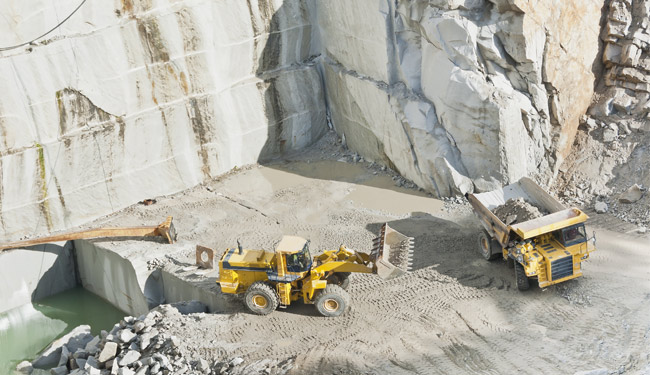
Modern marble production
Where is marble found?
Marble is found around the world making it a symbol of luxury in so many cultures. Today, four countries quarry almost half of the world’s marble. They are: Italy, China, India and Spain. However, many other countries produce marble, too.
As each seam of marble is formed by a unique set of circumstances, Marble from different quarries is often strikingly different. In some cases, even Marble from the same seam can look very different depending on the type and quantity of minerals present. This natural patterning is unrepeatable, each slab is completely unique however this does mean that Marble can be hard to match. This makes it important to make sure you order enough for your whole project at once.
So where is Marble found closer to home?
At Surrey Marble & Granite we are experienced natural stone experts, helping customers and trade to create, deliver and install amazing marble features in their home or business.
Our professional team are on hand to offer a smooth experience from initial enquiry to complete installation and aftercare. We offer a wide variety of different colours and styles of marble that can be made into a range of features for your home including bathrooms, kitchen worktops, Marble Staircases, stone flooring and more. You can see some of our most popular Marble stones in our related stones below, very popular with the recent Green Kitchen Trend that we’re seeing in 2022!
Speak to one of our Marble experts today to discuss your design requirements.
